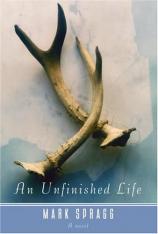Reading Group Guide
Discussion Questions
An Unfinished Life

1. Near the opening of the novel Griff thinks, "Everybody's mother is good at something. Her mother's good at finding the same man, no matter where he lives" (p. 8). How has Griff been affected by witnessing Jean's abuse by her boyfriends?
2. What does Griff's diary tell us about her feelings for her mother? What is good about their relationship? Which scenes indicate that Jean is a good mother? What does Griff admire about Jean?
3. How important are routines in the lives of Mitch and Einar? What human qualities do their daily actions express? Does the novel suggest that it is routine that keeps them alive? How does the appearance of Jean and Griff alter these routines, and who benefits from the changes?
4. What changes in the novel when the setting switches to Wyoming? What is the effect of Wyoming life and landscape on Griff?
5. As he massages Mitch's shoulders, Einar "knows if he shuts his eyes he'd forget they weren't the same man, that he wasn't working the liniment into some scarred part of himself" (p. 21). Why is the bond Einar feels with Mitch so profound?
6. How do details like Mitch's dreams and his antler carvings illuminate his character? In what ways is Mitch's personality a counterpoint to Einar's, particularly in their dealings with Griff?
7. In which stereotypes of battered women does Starla, the sheriff's receptionist, believe? What acts of bravery does Jean commit to create a better life for herself and Griff? How accurately is domestic violence depicted in the novel?
8. What is the significance of the bear in Mitch and Einar’s relationship? Why does Mitch want to set the bear free? Does the bear have a symbolic as well as literal presence in the novel? Why is the series of events involved in setting the bear free so important?
9. What do we learn about Jean when she visits her old family home? What do we learn of her relationship with Griffin? Why does she put her box of belongings back into the hole in the closet floor (p. 172)? What does it mean for her "to believe in chance as random as weather" (p. 172)?
10. The story proceeds at a quick pace, with some details about the characters' pasts implied but not stated directly. For instance, how long ago was Mitch attacked by the bear? When did Einar start drinking heavily? What was Ella like, and what did she die of? What other questions does the plot suggest but not address? Does it matter that these questions aren't answered?
11. Which scenes, and which details, best express the way Einar reacts to the realities of aging? How does he attempt to combat the aging of his body, and for what reasons? Why has Spragg chosen an excerpt from Mark Strand's poem "Not Dying" for the novel's epigraph?
12. Describe the most admirable elements of Griff's character. In which scenes does she seem indomitable, and in which scenes is she vulnerable and scared? In what way does Griff seem wiser than a typical nine-year-old, and how has she become that way?
13. How do power and control define Roy's relationship with Jean? When is Roy most dangerous? If the novel can be said to have two dangerous antagonists, Roy and the bear, which-the human or the animal-is more threatening?
14. What did Einar value in the character of his son? In what ways does Griff remind him of Griffin? If Griffin's life was "unfinished" (43), as his father emphasized, does Griff represent to him a second chance for its completion?
15. How does Jean’s guilt affect her life and relationships? How does Einar’s grief affect his life and relationships? What does the novel suggest about people’s need to hold on to their pain? How do Jean and Einar change over the course of the novel?
16. Discuss the novel's structure and narration. In what order is the story presented? From whose point(s) of view is the story told? With which character(s) does the reader become most intimate?
17. Describe Mark Spragg's writing style. Is there a relationship between his style and the emotional impact of the story?
An Unfinished Life
- Publication Date: August 31, 2004
- Genres: Fiction
- Hardcover: 272 pages
- Publisher: Knopf
- ISBN-10: 1400042011
- ISBN-13: 9781400042012







